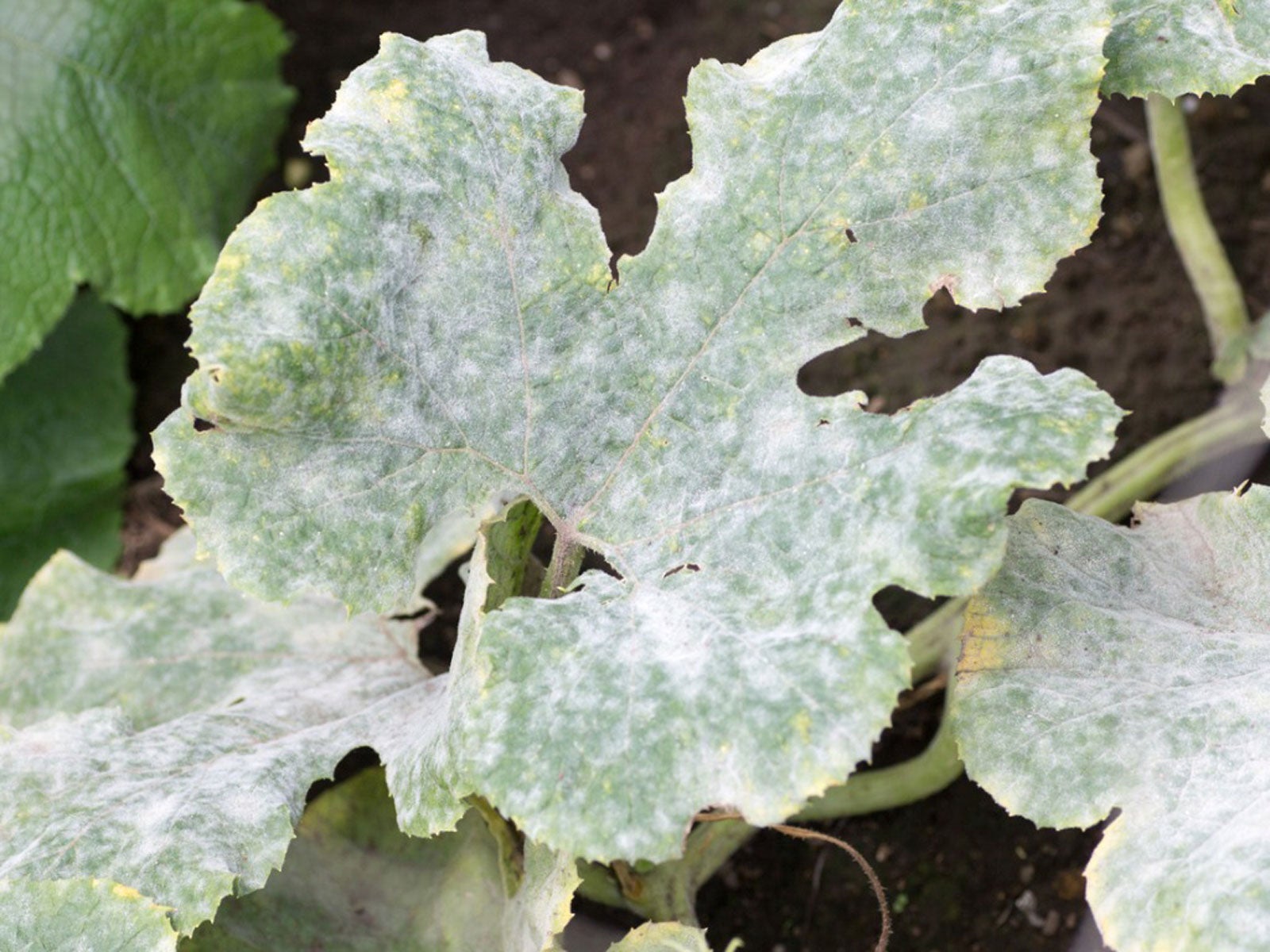White Pumpkin Leaves: How To Get Rid Of Powdery Mildew On Pumpkins

Do you have white, powdery mildew on your pumpkin leaves? You’re in good company; so do I. What causes white pumpkin leaves and how can you get rid of that powdery mildew on your pumpkins? Keep reading to find out more about treating powdery mildew on pumpkin plants.
What Causes White Pumpkin Leaves?
The reason we have powdery mildew on our pumpkin leaves is due to a leaf-infecting disease that is very common. The name is, in fact, “powdery mildew” and is given to a group of diseases caused by related fungi. Each one has a different host, but they all share the same appearance – a grayish white, powdery carpet that can be seen on leaves, stems, and flowers. Unlike other fungal diseases, powdery mildew thrives in warm conditions and does not require moisture to grow.
How to Get Rid of Powdery Mildew on Pumpkins
While powdery mildew on pumpkins looks unpleasant, the good news is that a mild case isn’t fatal. That said, if left untreated, the disease will likely spread. Powdery mildew first appears as white, powdery spots. These spots gradually spread and a pumpkin that is severely affected may have a reduced yield, shorter growth time, and pumpkins with little flavor. Before learning about treating powdery mildew on pumpkins, it’s a good idea to learn a little about its life cycle. In the spring, fungi begin to produce spores, which are then dispersed into the air. When they contact an appropriate host and conditions are suitable, they infect the plant. The initial white spots continue to expand and join as the infection progresses. The fungus overwinters on plant debris and then when the weather warms over 60 degrees F. (16 C.), the cycle starts all over again. Although powdery mildew doesn’t require watery conditions to germinate, high humidity is a factor. High humidity fosters spore formation. Temperatures between 60 and 80 degrees F. (15-26 C.), shade, and high humidity are premium conditions for powdery mildew. If the powdery mildew on the pumpkins seems to be minimal, remove the infected leaves, vines, or blossoms. Depending upon when the infection set in, this may give the plant enough time to complete the production of its pumpkins. If conditions are still favorable for the growth of powdery mildew, it will likely reappear again. Cucurbits, like pumpkins, are highly susceptible to this disease. Plant them in full sun, allow for good air circulation, and avoid excess fertilizer to try and thwart the disease. Use a slow-release fertilizer. It is likely that they will need an application of fungicide, however. Fungicides fall into the categories of protectants, eradicants, or both. There are two oils that work best as eradicants but have some protectant quality as well – neem oil and jojoba oil. Other horticultural oil brands may also be used. Don’t spray within two weeks of a sulfur spray or when temps are above 90 degrees F. (32 C.). Sulfur has been used for centuries to manage powdery mildew in pumpkins and other cucurbits but must be used BEFORE disease symptoms appear. Don’t apply sulfur when it is near or over 90 degrees F. (32 C.) or within two weeks of an oil spray. Lastly, you can try a biological fungicide (Serenade), which contains beneficial microorganisms that destroy fungal pathogens. It is nontoxic to people and pets and kills the powdery mildew pathogen but isn’t as effective as oil or sulfur.
Gardening tips, videos, info and more delivered right to your inbox!
Sign up for the Gardening Know How newsletter today and receive a free copy of our e-book "How to Grow Delicious Tomatoes".

Amy Grant has been gardening for 30 years and writing for 15. A professional chef and caterer, Amy's area of expertise is culinary gardening.
-
 Looking For Plants To Give You The Soft And Fuzzies? Try These 5 Fuzzy Leaf Plant Options
Looking For Plants To Give You The Soft And Fuzzies? Try These 5 Fuzzy Leaf Plant OptionsLovers of texture, drama, silver foliage and tactile plants will adore these special sensory garden additions. These fuzzy leaf plant options will leave you all aglow
By Susan Albert
-
 Get Ready For A Summer Of Hummers! Grow These Full Sun Hummingbird Plants and Flowers
Get Ready For A Summer Of Hummers! Grow These Full Sun Hummingbird Plants and FlowersIf you’re lucky enough to enjoy a sunny backyard, make sure you are maxing out on your pollinator opportunities and grow these full sun hummingbird plants and flowers
By Tonya Barnett